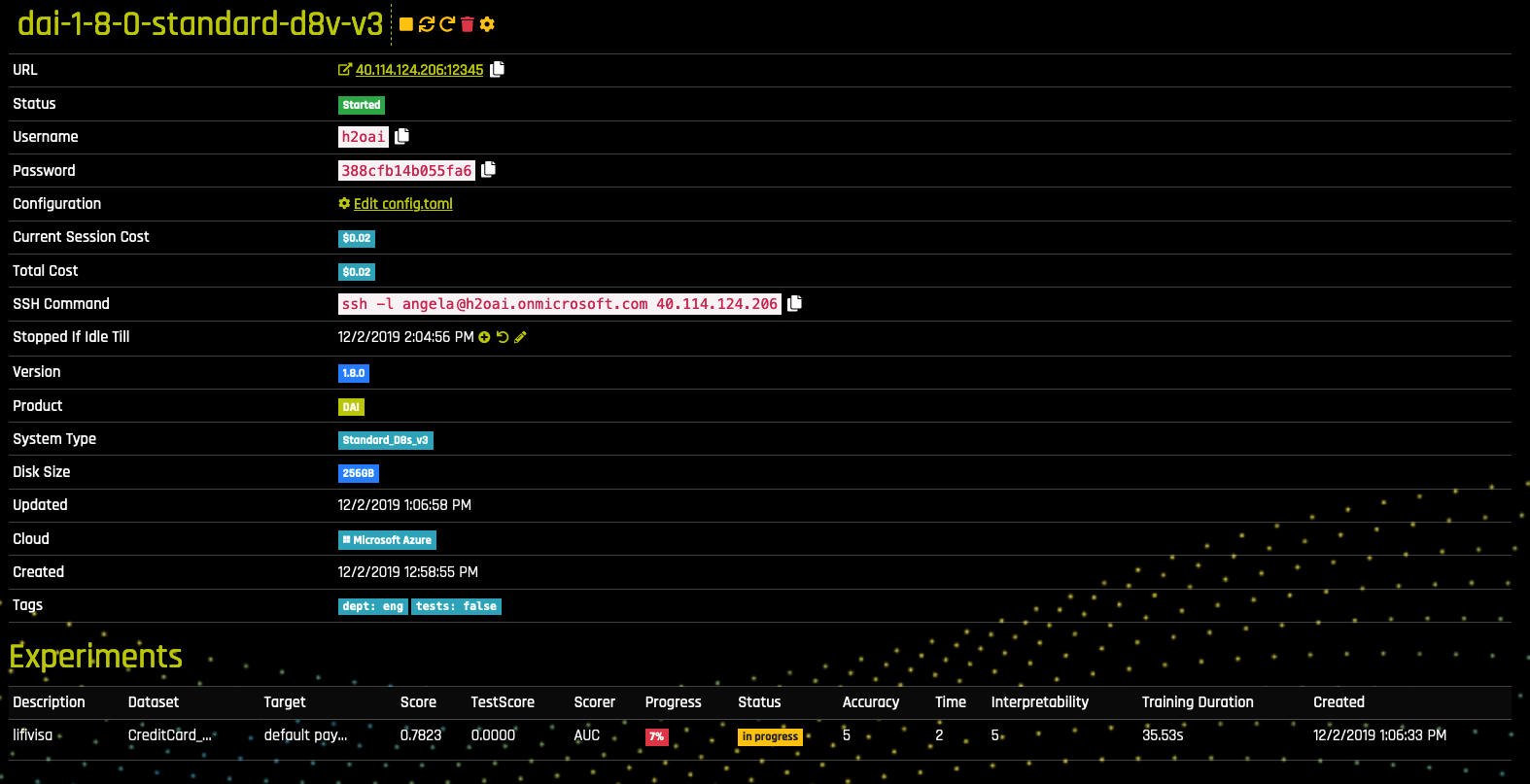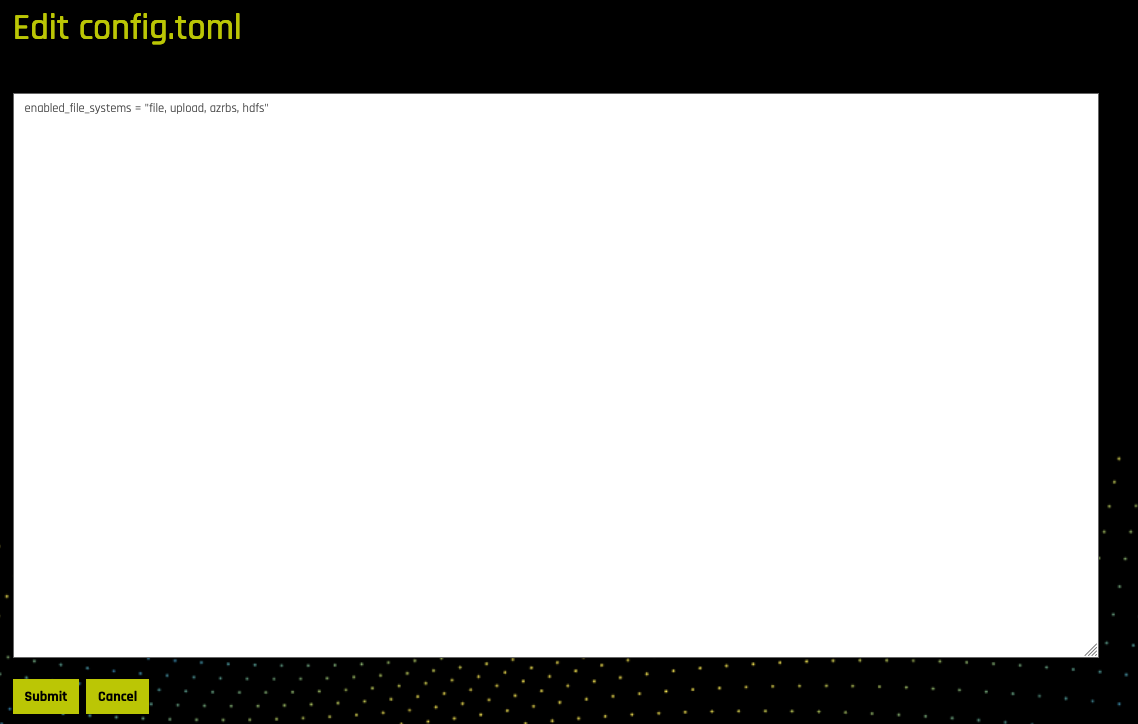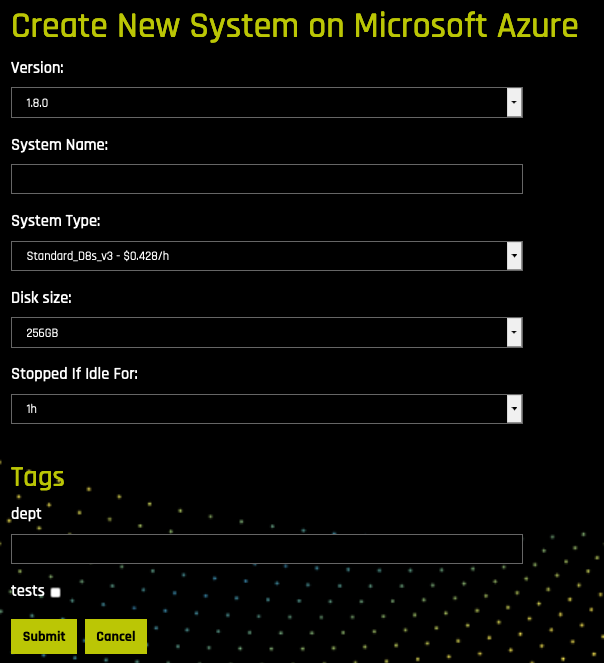Create New Driverless AI System¶
This section describes how to create a new Driverless AI system.
Note: You must have a Driverless AI license in order to run Driverless AI in Puddle. You can request a free 21-day trial license at https://www.h2o.ai/try-driverless-ai/.
- Click Create New Driverless AI System on the Puddle Systems page.
- If prompted, select the cloud environment for the new system.
- Specify the following options to create the system:
- Driverless AI Version: Available versions are added by Admins.
- System Name: System names must be between 1 and 64 characters and contain only lowercase characters, numbers, and hyphens. It must start with a letter and end only with a number or letter. This is blank by default.
- System Type: Available system types are added by Admins.
Note: Your account settings may include a limit as to the number of systems of a certain type that you can run. If you exceed that limit then that option will not be available, and the least expensive option will then become the default.
- Disk Size: This can be 256GiB (default), 512GiB, or 1TiB.
- Stopped If Idle For: This can be 30 min, 1 hour (default), 2 hours, 3 hours, 4 hours, or Never.
- Tag: This shows the Tag(s) that will be applied to this system. Tags are created by Administrators and might include a default value. You can set the value here.
- Click Create System when you are done. The system will begin provisioning. Note that this can take several minutes.
After the system has successfully started, it will appear on the My Systems page. At this point, you are ready to use Driverless AI.

Viewing Driverless AI Systems¶
Click on the Driverless AI System Name to view the configuration information and a list of current experiments.

This page provides general system information and Driverless AI model information (if any models exist)
System Information¶
- The URL for launching Driverless AI
- The system status
- The Username and Password for starting Driverless AI
- An link to edit the config.toml file for that system. Note that a system Reboot or Restart is required after editing the config.toml file.
- The current session cost
- The total cost so far for this system
- The SSH command to run in order to securely access the system that is running Driverless AI. (See SSH into the Driverless AI System below for more information.)
- The time when the system will stop if remaining idle. There are several operations that can be done with the idle timeout:
- Extend the timer for this session. If you click this button, 1 hour will be added to the timer. You can execute this operation multiple times. This is useful when the system should not be stopped for a certain number of hours, for example when uploading large files.
- Reset the timer. For example, if you reset the idle timeout of system, which has the idle timeout interval set to 1 hour, the system will be stopped after 1 hour from clicking this button, provided there are no experiments in progress.
- Edit the idle timeout interval. This allows you to edit the idle timeout interval of the system. You can specify a new idle timeout of Never, 4 hours, 3 hours, 2 hours, 1 hour, or 30 min.
- The product name and version currently running on the system
- The system type and disk size
- The updated and created dates
- The cloud environment
- The system tag (if Admins have set up tags)
Experiment Information¶
The Experiments portion of this page will populate after you start a Driverless AI experiment. For each experiment run on Driverless AI through Puddle, the following information displays:
- A description that includes the experiment key
- The training dataset used in the experiment
- The target column
- The validation score
- The test scorer
- The scorer used for the experiment
- The experiment progress and status
- The Accuracy, Time, and Interpretability options used for the experiment
- The amount time it took to complete the experiment (in seconds)
- The time when the experiment was created
Starting Driverless AI¶
- Click on the URL provided in the Driverless AI system page. This takes you to the DNS of the URL.
- If this is your first time starting Driverless AI on this system, or if you have restarted the system, accept the license agreement.
- You might have to enter the Username and Password that are provided on the Driverless AI system page.
- If this is your first time starting Driverless AI on this system, you might have to enter your license key. Note that if you do not have a license key, you can request a free 21-day trial license at https://www.h2o.ai/try-driverless-ai/.
Upon completion, Driverless AI will open on the Datasets Overview page. At this point, you can add or upload datasets and begin running experiments.

In Driverless AI, click on Resources > Help to view the Driverless AI User Guide. Additional documentation for Driverless AI is available at docs.h2o.ai.
SSH into the Driverless AI System¶
Puddle provides the ability to SSH into a system that is running Driverless AI. There are two ways that you can SSH into a system:
The method to use depends on which cloud environment you are working in (Microsoft Azure or Amazon AWS).
Using Your Azure ActiveDirectory Credentials¶
Follow the steps below to SSH into a Driverless AI system that was created on Microsoft Azure.
- Select the system that you want to SSH into.
- On your local machine, run the provided SSH command.
- You will be prompted to continue the connection. Type
yes. - After the URL is added to your list of known hosts, you will be provided with a login URL and password. The message will be similar to the following:
To sign in, use a web browser to open the page https://microsoft.com/devicelogin and enter the code AXXXXXXXH to authenticate. Press ENTER when ready.Open a browser and follow the instuctions in the terminal message.
- After you correctly enter your login and password in your browser, the following message will display.

Return to your terminal window and press Enter. Upon completion, you will receive a welcome message.
Using the Custom SSH Keys¶
Follow the steps below to SSH into a Driverless AI system that was created on Amazon AWS.
- Download the SSH private key using the download button to the left of the ssh command.
- On your local machine execute
chmod 600 <ssh_key_file>to set the correct permissions on the private key file. - On your local machine, run the provided SSH command. Please be sure to specify the correct path to the private key file in the SSH command.
Editing the config.toml File  ¶
¶
In Driverless AI, the config.toml file allows you to specify system-wide configuration options. Perform the following steps to edit the config.toml file. Note that a system reboot ( ) or Driverless AI restart (
) or Driverless AI restart ( ) is required when changes are made to the config.toml file.
) is required when changes are made to the config.toml file.
There are two ways to open the config.toml editor:
- Click the Edit config.toml link in the Driverless AI System information table.

- Click the Edit config.toml button (
 ) beside your system name on the Driverless AI System page.
) beside your system name on the Driverless AI System page.
- Specify the variables that you want to include.
- Click Submit.
- Reboot or restart the system.
A list of available variables is included in the Driverless AI documentation for the config.toml file. Note that this link points to the latest version of the config.toml file. The User Guide that’s available in your system’s Driverless AI under Resources > Help includes the config.toml file that matches your running Driverless AI version.

Stopping a System  ¶
¶
Click the Stop button ( ) to halt a system that is in a “Started” state. No information will be lost when a system is stopped.
) to halt a system that is in a “Started” state. No information will be lost when a system is stopped.
Starting a System  ¶
¶
Click on the Start button ( ) to start a system that is in a “Stopped” state. This will launch a new system with a new URL. All prior data will still be available from this URL.
) to start a system that is in a “Stopped” state. This will launch a new system with a new URL. All prior data will still be available from this URL.
Rebooting a System  ¶
¶
Click the Reboot button ( ) to reboot a system that is in a “Started” state. This will stop the system and launch a new system with a new URL. All prior data will still be available from the new URL. The entire process can take several minutes. Note: A reboot (
) to reboot a system that is in a “Started” state. This will stop the system and launch a new system with a new URL. All prior data will still be available from the new URL. The entire process can take several minutes. Note: A reboot ( ) or Driverless AI restart (
) or Driverless AI restart ( ) is required when you change the config.toml file.
) is required when you change the config.toml file.
Restarting Driverless AI on a System  ¶
¶
Click the Restart Driverless AI button ( ) to restart Driverless AI on a system that is in a “Started” state. This will restart the Driverless AI without restarting the virtual machine. The URL is preserved in this case. All prior data will still be available. The entire process can take few minutes, but it is much faster than the Reboot (
) to restart Driverless AI on a system that is in a “Started” state. This will restart the Driverless AI without restarting the virtual machine. The URL is preserved in this case. All prior data will still be available. The entire process can take few minutes, but it is much faster than the Reboot ( ) option. Note: A reboot (
) option. Note: A reboot ( ) or Driverless AI restart (
) or Driverless AI restart ( ) is required when you change the config.toml file.
) is required when you change the config.toml file.
Changing the Size of a System  ¶
¶
Click the Scale button ( ) to resize the System. This will change the size of the underlying VM. All prior data will still be available. It is possible to scale only stopped systems.
) to resize the System. This will change the size of the underlying VM. All prior data will still be available. It is possible to scale only stopped systems.
Deleting a System  ¶
¶
Click the Delete button ( ) to completely remove a system. A confirmation page will display asking if you are certain about deleting the system. Click Yes complete the delete. This request deletes the system and destroys all data that is on the system.
) to completely remove a system. A confirmation page will display asking if you are certain about deleting the system. Click Yes complete the delete. This request deletes the system and destroys all data that is on the system.
Marking a System as Failed  ¶
¶
This is a recovery option. Use this if your system is stuck (for example, in a “Starting…” state). Click the Mark as Failed button ( ) to mark a system as failing. After a system is marked as failed, you will be able to stop (
) to mark a system as failing. After a system is marked as failed, you will be able to stop ( ) or terminate (
) or terminate ( ) the system. Note that only “provisioning” and “stopped” systems can be marked as failed.
) the system. Note that only “provisioning” and “stopped” systems can be marked as failed.


